
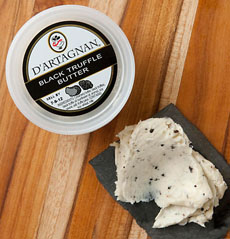
Butter flavored with truffles is a variety of compound butter (photo © D’Artagnan).
May 2005
Last Updated June 2022
|
 |
Butter Glossary: Different Types
Of Butter
Terms & Definitions: D To G
Butter terms beginning with D to G, including dessert butter, flavored butter, fruit butter, garlic butter and ghee. If you’d like to suggest others terms, use the Contact Us link on this page. This is Page 3 of a seven-page glossary. Click on the black links below to visit other pages. If you love to learn about food, see our many other food glossaries.
DANISH-STYLE BUTTER
Usually unsalted, cultured butter. A culture is added to the cream and allowed to stand overnight for the acid flavor to develop before churning.
DESSERT BUTTER
A sweet compound butter that is used either in cooking, to make a hard sauce, or to serve as a spread with a plain, breadlike dessert such as zucchini bread or carrot bread. Examples for the latter include strawberry butter; other examples include rum butter for steamed puddings.
|
|
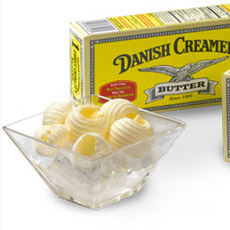
Danish cultured butter (photo © Challenge Dairy).
|
DRAWN BUTTER
See clarified butter. Called ghee in India.
EUROPEAN-STYLE
European-style butter is made with more milkfat and lower moisture than regular American butter. Butter with more than 82% milkfat is considered European-style. It is churned longer than traditional butter, decreasing the moisture content and increasing the fat content. The result is a richer, creamier butter for cooking and a smoother texture for spreading. Some European-style butters, such as that from Straus, are as high as 85% to 86%. Plugrá is an American brand made in the European style; European imports such as Kerrygold are also available. Since European-style butter has a lower moisture content, using it results in better pastries, icings, and sauces.
|
|
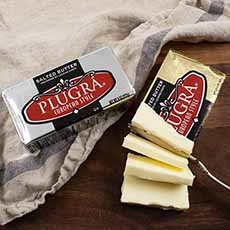
Plugrá is European-style butter made in the U.S. (photo © iGourmet).
|
FLAVORED BUTTER
See compound butter.
FRUIT BUTTER
Fruit butter, such as apple butter, is a thick fruit spread for bread made by slowly cooking fruit, sugar, and spices together. It contains no butter or other dairy product. It is referred to as butter because of its spreadable consistency.
GARLIC BUTTER
Butter is a compound butter (flavored butter) that is blended with garlic (chopped, crushed, minced, or garlic powder). The intensity of the garlic flavor is a function of the amount of garlic used and the amount of time the mixture is allowed to stand. Two of the most popular uses are garlic bread and escargots (photo at right). It can also be used to garnish meat, fish, seafood, pasta, potatoes, and other vegetables.
|
|
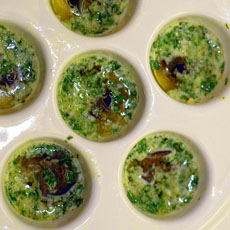
Garlic butter with escargot (photo © Olga Massov | Sassy Radish).
|
GHEE
A relative of clarified butter that originated millennia ago in India. It is taken a step further than traditional clarified butter by simmering until all of the moisture evaporates and the milk solids begin to brown, giving the butter a nutty, caramel-like flavor and aroma. This extra step also gives ghee a longer life and much higher smoke point than regular clarified butter, almost 485°F/252°C*. This makes ghee the best butter for sautéing and frying. Today, the best commercial ghee comes from Holland, followed by Scandinavia and Australia. While ghee was originally made only with unsalted butter made from water buffalo milk, today it can be made with any unsalted butter; the healthiest ghee, with conjugated linoleic acid and vitamin K2, is made from grass-fed cow’s milk.
|
|
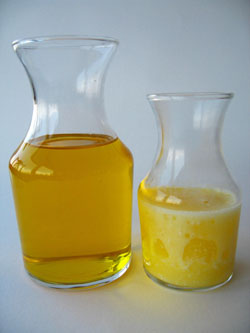
At left, melted ghee, clear and golden. At right, melted butter, cloudy and foamy (photo by Emily Chang © The Nibble). |
Flavored ghee is created by adding ginger, peppercorns, cumin et al at the beginning of the clarifying process. See our review of Ancient Organics Ghee, which includes a recipe for making ghee.
You can substitute ghee for cooking oils in any recipe.
*Per Wikipedia; other sources say 375°F.
GRAINY
A grainy condition imparts a granular consistency when the butter is melted on the tongue.
GRITTY
Attributable to the use of too much salt or undissolved salt due to insufficient working of butter.
Continue To The Next Page: Terms Beginning With H
Go To The Article Index Above
Some content courtesy of Cornell University School of Agriculture, Wisconsin Milk Marketing Board, U.S. Department of Agriculture.

|








